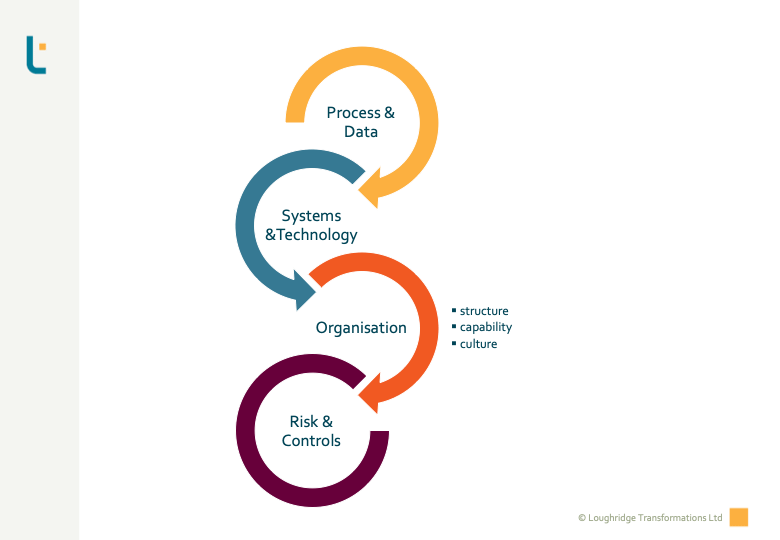Delivery – Design and Prepare for Robust Finance Transformation

AUTHOR: JENNIFER LOUGHRIDGE
PRINCIPAL CONSULTANT
Jennifer is a Senior Executive Finance professional with 17+ years of global experience. She specialises in Finance Transformation and Continuous Improvement, with particular expertise in Strategy, Performance Management, Business Partnering, Commercial Decision-Making, Corporate Governance and Valuation.
jennifer.loughridge@loughridgetransformations.com
In our last post in this nine-part series, we looked at Understand the Context. First, we looked at the importance of understanding what is happening around you. Then, we introduced lenses that help identify what might impact your transformation.
This post will focus on the seventh of the nine steps: Design and Prepare for Delivery. We will touch on project and change management and focus on what is particularly pertinent to Finance Transformation.
Preparing for Successful and Sustainable Delivery
If you have been following the Loughridge Transformations method, you will, by now, have covered the following steps:
We are now entering the design and deployment phases of Finance Transformation: Design and Prepare for Delivery. You may have been eagerly awaiting this phase. The preceding steps are all worthwhile, but this is the moment the rubber hits the road.
Get the Delivery Basics in Place
Before looking at the project specifics of Finance Transformation, it is worth touching on a few project and change management elements, which are vital for a successful and sustainable transformation.
Design and Prepare for Delivery: Sponsorship
At Loughridge Transformations, we rarely advise undertaking projects or programmes without clearly defined and active sponsorship. It is vital for projects or programmes with a transformative nature to identify and work with engaged sponsors throughout the change. A transformational activity cannot be delivered “behind the scenes” or “bottom-up”. Without the right kind of well-deployed sponsorship with the right level of authority and pro-activity, it is unlikely to complete the transformation on budget or schedule.
Design and Prepare for Delivery: Implementation Readiness
In our last post, we discussed understanding the context. That is part of implementation readiness. In addition to sponsorship, it is crucial to take the preparatory change actions for transformation. Different methodologies will tackle this in a variety of ways. Select whichever method suits you and your organisation’s culture, but assessing and investing in readiness is essential. Take time to consider the perceptions and experiences of your targets for change:
- How many changes have occurred previously?
- How were they managed?
- Does this change require different skills?
Taking the time to invest in readiness will save time and energy as you progress and the resistance emerges.
Design and Prepare for Delivery: The Programme Management Office
Finance Transformation nearly always has several components on, at times, conflicting timelines. Depending on the size and complexity, deployment may be on a roll-out schedule.
Furthermore, Finance Transformation programmes have many touchpoints with other programmes, external regulatory compliance, and ongoing operations. We find navigating this at Loughridge Transformations impossible without an experienced and well-resourced Programme Management Office (PMO). They bring rigour, attention to budget and schedule and an ability to facilitate the dilemma decisions the Programme Lead and Sponsors will inevitably face.
Design and Prepare for Delivery: Tools from the Toolbox
A top-notch PMO will support the Programme Lead in decisions on the right project and change tools. Knowing the sponsors’ and stakeholders’ perceptions and preferences in the organisation and organisational culture also enables appropriate tool selection. Next to that, the characteristics of Finance Transformation require robust structures. That does not necessarily mean avoiding agile approaches – particularly if the organisation has already embraced that way of working – but Loughridge Transformations have found that a StageGate method within a Project Delivery Framework (PDF) is a sound choice.
Design and Prepare for Delivery: Fundamental Design Steps
Before we look at the PDF application, it is a great moment to introduce the fundamental steps in Finance Transformation. In this post, we will only look as far as design. We will cover the subsequent steps next time.
Click to scroll through the entire sequence:
We will use a practical example later on to explore the detail of each of these steps, but now we will cover where those steps fit within the StageGates of the PDF.
Project Set-Up (SG1)
In addition to the critical project set-up deliverables we covered earlier in the post, it is also time to define the scope of the transformation.
Often, defining the scope for Finance Transformation is easier said than done. Objectives for the transformation are usually cost reduction, outsourcing, improvement in business-partnering capacity, or other things discussed in this series. First, however, the scope must be defined in process terms. In organisations that lack an enterprise or functional process model, that is even more challenging. That, however, is why we take the Functional Fit, and Baseline Assessment steps well before this point in the transformation. Process and Data go hand-in-hand, so the scope definition must include both.
The scope definition will also need to reflect the frame of reference of your targets; for example, you cannot assume that “removing” busy work” will be well received. Some may see it as a threat to job security. However, if you have adequately invested in readiness, your scope definition will follow that.
Analyse & Define (SG2)
The main deliverables at this StageGate are confirming the current situation – building on and deepening the Baseline Assessment, where necessary – and assessing risks to create a Risk Register.
Design (SG3)
In the design phase, you work up design principles in more detail, using the levers chosen earlier as input. The main piece of design work then follows.

The design sequence we introduced together with the Baseline Assessment is an overarching design principle that we, at Loughridge Transformations, advocate strongly.
With the scope of processes already agreed upon, the work to define the process steps begins. At this stage in the design, at least the Operational Process Description, commonly known as Level 5, should be targeted. In addition, Depending on the organisation’s process maturity, Level 7 Work Instructions may be in scope.

We will use a real-life example for the remaining Design and Prepare for Delivery steps. The StageGates beyond Design will be part of the next post.
Design and Prepare for Delivery: Putting the Fundamental Design Steps into Practice
The Scenario
For this example, we will return to the mid-large-sized global organisation. Following an earlier strategic decision, shared-service centres are already operating. The distinction between shared-service centres and outsourcing is not relevant in this case. More concerning is that the returns on this decision are not materialising as anticipated. Consequently, there is increased noise about this within the organisation. Discussions on “back-sourcing” the migrated activities are starting to take place.
Luckily, despite the challenges that are currently ongoing, the organisation has decided to conduct a thorough analysis of what is not working. They partly suspect that “halfway” migration could be part of the root cause. As a result, they remain potentially open to deepening the migration.
You are leading this project. Given this project’s size and wide-ranging organisational implications, you want to ensure a fit-for-purpose project and change management approach. As discussed above, this is not the moment to scrimp on the project and change deliverables. You select a PDF with StageGates and recruit an experienced PMO.
Project Set-Up
You are ready to start preparing for StageGate One: Project Set-Up. With the PDF selected and PMO recruited, you can work on finding the right sponsor. In this project, there will be an impact on both the on-shore and off-shore organisations. They have different reporting lines, so you approach the person in the organisation with the right influence, authority and ability to remove any potential stumbling blocks that may come up.
With different organisational cultures, sponsors expect different ways of working. Typically you can expect a hands-on style of running and leading the project daily, including minor decision-making. You would, however, involve your sponsor when it comes to major decision milestones, removing significant hurdles or actively supporting change management. In this case, you have a well-respected sponsor with a delegating leadership style. She leaves you to get on with things but is always there to actively support you with actions and decisions when needed.

Scope definition is the other significant deliverable, and that includes, amongst others, Manage Close and Performance Management. Given the scale of this particular project and the number of processes involved, you decide to use Level 2 from the Process Architecture in your StageGate documentation.
Analysing the Data
Onto StageGate Two: Analysing and taking data from the Baseline Assessment as a starting point, we deepen the understanding of the current shared-service centre performance.
Initial Investigations
You discover that the shared-service centre is currently focused on data processing and not touching the more complex parts of the processes. When looking at the process steps within the migrated processes, you learn that the process steps relating to initiation, preparation, and review have remained with the on-shore organisation. The migrated process steps are primarily data input and processing. Looking at, for example, Manual Journal Entries, you find the following:
| Sub-Task | Complexity & Time Spent | Operated |
|---|---|---|
| Initiate & Prepare Entry | High | On-Shore |
| Input to ERP | Low | Off-Shore |
| Review & Approve Entry | Medium | On-Shore |
You can see that the shared-service centre team only performs the process step with the least time-consuming and complicated activities. But unfortunately, it is not an uncommon scenario. Because these activities are the least time-consuming and have minimal training requirements, many organisations migrate these activities first.
As a rule of thumb, organisations do not achieve the cost or process performance improvement sought with such migrations. On the contrary, costs are most likely to increase. This cost increase happens because of a lack of process ownership, fragmented responsibilities, and further inefficiencies.
Further Investigations
You then discover that there was no intent to migrate the ERP-input tasks solely at the time of migration. Instead, it turns out that a more extensive scope was migrated. For manual journal entries, for example, all three sub-tasks were scoped for migration. However, due to poor handover, lack of communication and poor definition of accountabilities and responsibilities, the on-shore teams have been drawn into assisting with error correction and issue resolution.
Over time these behaviours led to duplication of work and other inefficiencies. However, no one has addressed the root causes. We have seen many real-life examples of unhealthy “master-servant” relationships between on- and off-shore organisations.
Risk Register
One of the essential StageGate two deliverables is the risk register. In no particular order, you determine the following risks based on an “as-is” analysis:
| Risk | Consequence |
|---|---|
| Fragmented Accountability versus Responsibility | Blame culture and limited sense of process ownership |
| Insufficient attention to the requirement for new ways of working. | Weak, ineffective communication and building frustrations between on- and off-shore teams |
| Overlooking data clean-up requirements at the time of migration. | Migrating “dirty” data and partly or wholly broken processes result in neither on- nor off-shore teams taking ownership. |
| Lack of Process Expertise due to original on-shore process experts no longer being in role and new off-shore process expert roles not being defined. | Difficulties in process issue resolution |
| Poor quality, or no, work instructions were produced, approved or handed over at the time of migration. | Many basic errors from off-shore team members and subsequent duplication of work in the on-shore teams |
We assume that at StageGate Two, you propose re-migrating existing processes and migrating additional processes. The aim is to deliver optimised, end-to-end processes with standardisation, clear boundaries, roles and responsibilities/accountabilities and new ways of working. You obtain approval for this and move to the next phase!
Design Principles
StageGate Three is the Design phase. Before starting the detailed design, you must determine the critical design principles by referencing the chosen levers. In this project, you select:
- Migrate (where possible) the end-to-end process
- Where associated controls exist, they migrate together with the process
- Clear hand-offs between on- and off-shore organisations
- Eliminate, Simplify, Standardise, and Automate Process Design
- Clear responsibilities/accountabilities in the on-shore organisation as with an increased process maturity, the jobs in the organisation will change focus.
- New ways of working leveraging more effective communication based on a better understanding of behavioural preferences and systemic solutions
You are now ready to start the design journey with these design principles. But, of course, these principles are not universal. Instead, each transformation will have different principles stemming from the specific choice of levers at an earlier stage.
Process Design

The identified risks and shortcomings with the AS-IS migration and process design, combined with the TO-BE design principles, now form the cornerstone in your re-design of the process, data and migration scope.
A proven effective way of designing a Level 5 TO-BE end-to-end process is to start drawing up the entire process in a flowchart that clearly shows roles, tasks – both manual and system via ERP or other – any control points and hand-off points between roles. In addition, data quality standards should also be part of the design. In this way, you can avoid “dirty” data migration. Finally, a data clean-up team will have to resolve the existing issues in this scenario.
As a result, you now have a one-page view of the TO-BE end-to-end process design. It also forms a sound basis for writing work instructions (Level 7) with detailed descriptions of each task.
Systems & Technology Design

It is vital to have the design principle concerning Eliminate, Simplify, Standardise, and Automating at the forefront of re-design. Therefore, before considering automation, you must first have applied the Eliminate, Simplify and Standardise thinking.
We assume that your organisation is not initially looking to implement or invest in new systems and technology; however, that does not mean that this step can be skipped. Typically, you’ll want to use your existing system’s increased functionality in your TO-BE design. Higher utilisation gives your organisation an increased return on the current investment. It can also be tangible proof of the existing limitations and an argument for future technology investment.
Risk & Control Design

In a flowchart format, you should have identified the risks and control points with your Level 5 TO-BE design. Next, compare this with the current risks and controls. In some cases, you will find that the existing risks are still valid. In other cases, you will identify revised or new risks. There will inevitably be some requirement for a re-design of existing controls – if only to update the roles/owners – and once you have completed designing the control component, you should then integrate it into the new or revised work instruction.
Lastly, keep a strict audit trail or log any proposed changes to the existing controls. They will likely be subject to Senior approval(s), potentially outside the StageGate approval process. Furthermore, you can expect internal or external audit scrutiny of your revised control framework.
Organisation Design

By now, you have a clear view of the process steps, which steps are manual or automated, and the controls that will need owner and executor roles. The process steps can, as a result, be grouped naturally to form roles, and user access profiles can be designed to fit them. Control ownership and execution can then be assigned to roles, considering the segregation of duties.
Often, the focus in process role design is on the off-shore organisation. However, even though the process roles on-shore may be less detailed, there is an enormous benefit in completing this design for the entire organisation as it – amongst others – enables a better distinction between accountability and responsibility within the process.

Determining the location for each process role is the next critical step. The location can be on-shore, a centre of excellence or off-shore. Consequently, discussions around business proximity, resourcing and skill availability, and time zones will need to occur. These tend to be very organisation-specific.

Once the roles and locations are defined, they can be mapped into jobs. Note that an individual can be mapped to more than one job in the reporting structure. We will cover this specifically in our next post addressing deployment.

With jobs per location known, appropriate reporting structures can then be designed.

Lastly, each job’s competence and behavioural requirements can be detailed based on the process roles.
Design and Prepare for Delivery: What’s Next?
Finally, with this detailed work complete, you are ready to move to StageGate Three and seek approval for the integrated design. You are well on the way to successful and sustainable delivery. In our next blog, we will continue with the deployment steps.
Find Out More About Working with Loughridge Transformations
Get the Latest from Loughridge Transformations
Subscribe to Our Blog
Alternatively, take a look at our most popular blog posts:
Looking for something else? Here’s what we have been blogging about recently:
Agile Analytics Associates Automation Behaviours Building Trust Business-Partnering CFO Remit Change Management Coaching Collaboration Continuous Improvement Control Design Corporate Governance Data Deployment Design Principles Digital ERP ESG Finance Function Finance Transformation Implementation Migration Off-Shoring Organisation Organisation Design Process Process Design Process Governance Process Performance Productivity Programme Management Office Project Management Readiness Risk & Controls Skills sponsorship Standard Organisational Model Strategy Systems Systems Design Technology Transformation Virtual Working











